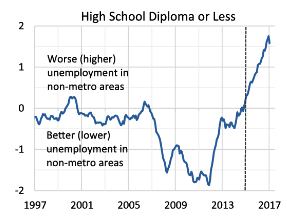Unemployment rates are down in cities, especially for those with less education
One of the trends we’ve been following at City Observatory has been the increasing shift of the driving forces of the nation’s economy to large metro areas, and within these areas to cities. The industries that are flourishing in today’s economy are ones that are most competitive and productive in urban environments. As a result, the locus of opportunity in the US is shifting toward cities, and away from rural areas. There are a variety of ways of measuring this shift, and one is to look at trends in the labor market, with a focus on variations in unemployment rates over time between cities and rural areas.
A new study from the Board of Governor’s of the Federal Reserve System, Labor Market Outcomes in Metropolitan and Non-Metropolitan Areas: Signs of Growing Disparities, charts the relative progress of urban and rural areas in reducing unemployment. Fed Economist Alison Weingarden notes that as the economic expansion has proceeded, unemployment rates have come down much more sharply in large metro areas than in smaller ones and in rural areas. In the 1990s and the first decade of the 2000s, unemployment patterns among prime aged workers (those between 25 and 54) were fairly similar, and followed similar paths in large metros, smaller ones and rural areas. But since the Great Recession, a widening gap has emerged between relatively prosperous metro economies and struggling rural ones. Overall, unemployment rates in rural areas, which were roughly comparable to those in metro areas during the depths of the recession, are today noticeably higher. The latest data show rural areas unemployment rates seemed to have bottomed out at 5 percent, small metro areas have settled around 4.5 percent, and large metro areas have overall unemployment rates below 4 percent.
The economic fate of those with lower levels of education also seems to be relatively worse in rural areas. The Fed report compares the unemployment rate of those with a high school diploma or less in rural areas with those with the same level of education living in metro areas. Prior to the Great Recession, the two rates were similar, and during the worst of the recession and in the earlier years of the recovery, it was noticeably better for your employment prospects to be in a rural area if you had a limited education. But in the past four years, the unemployment rates for high school graduates in metro and non-metro areas have diverged sharply. Today, unemployment rates for those with just a high school diploma are nearly 2 percentage points higher in rural areas than in metropolitan ones.
These data are consistent with a continuing shift of economic activity to urban areas, and the limited opportunities, especially for those with less education, living in rural areas. Another implication of this data point is that even those with relatively less education (just a high school diploma) have better prospects of being employed if they live in a metro area than if they live in a rural one.
Weingarden, Alison (2017). “Labor Market Outcomes in Metropolitan and Non-Metropolitan Areas: Signs of Growing Disparities,” FEDS Notes. Washington: Board of Governors of the Federal Reserve System, September 25, 2017, https://doi.org/10.17016/2380-7172.2063



